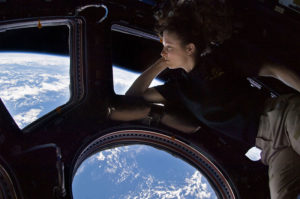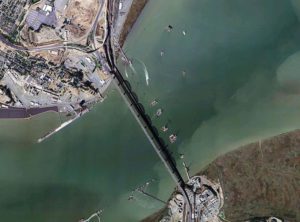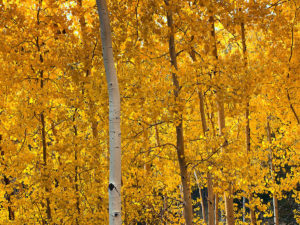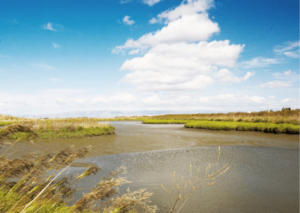“The thing that really surprised me was that it [Earth] projected an air of fragility. And why, I don’t know. I don’t know to this day. I had a feeling it’s tiny, it’s shiny, it’s beautiful, it’s home, and it’s fragile.”
–Michael Collins, Apollo 11
Introduction

Self portrait of Tracy Caldwell Dyson in the Cupola module of the International Space Station.
Have you ever been struck with a spontaneous sense of awe while surrounded by nature? If you have, there’s a name for that feeling: it’s called the overview effect. The overview effect is “a cognitive shift in awareness reported by some astronauts during spaceflight, often while viewing the Earth from outer space.” I haven’t been to space (yet), but I’ve experienced a feeling similar to what I imagine Tracy Caldwell Dyson felt as she looked down on Earth from the International Space Station.
This experience occurred unexpectedly and in an unlikely place—as a passenger crossing the Benicia-Martinez Bridge northeast of San Francisco.

Aerial view of Benicia Bridge. Image courtesy Wikipedia.
Moving at 65 miles per hour 138 feet above the water, the drive feels almost like flying. As the rolling hills stream past, the sunlight reflecting in the water and the infinite blue sky create a natural presence that feels timeless. They gave me a miniature version of the overview effect.
At the same moment, it was impossible not to notice the giant refinery complexes, located at both ends of the bridge and surrounded by the natural beauty of the bay. An aerial map view shows the industrial infrastructure sandwiched between the San Pablo Bay National Wildlife Refuge on the bridge’s NW side, Grizzly Island Wildlife Area to the NE, the Carquinez Strait Regional Shoreline to the SW, and the Point Edith Wildlife Area on the SE side of the bridge.
It was an odd juxtaposition of industrial chaos and natural splendor. As I looked out the window, I wondered how much pollution gets released each day into the earth, air, and water from those facilities. I wondered when the last “pollution incident” was and when the next one might happen.
More importantly, I wondered, how does nature manage to reverse the damage we create?
I’ve found a few biological strategies that nature uses to reverse pollution from AskNature.org. My hope is some of these same ideas can be applied by scientists and companies. Maybe they too have been touched by that same lightning strike of awareness as I was looking out from the bridge. Earth is our only home, and we have some serious cleaning up to do.
Earth
Breaking down pollutants—especially hydrocarbons—isn’t easy, but nature does have some effective strategies to get the job done. Hydrocarbons are chemical compounds made up of carbon and hydrogen. They find their way into the soil as pollutants from oil and natural gas, as well as from manufacturing products like plastics, rubber, and solvents.

Pigeon Pea crop. Image courtesy Wikipedia.
Luckily, the roots of plants coexist with trillions of specialized bacteria. In a strategy documented on AskNature, a particular kind of bacteria known as rhizobacteria takes chemicals in the soil and turns them into useful chemicals for plant growth. These same bacteria can also break down hydrocarbons, helping to reverse the damage done by oil and natural gas products.
A similar study in Nature describes how scientists are finding ways to combat the toxic effects of petroleum oily sludge (POS) compounds with Cajanus cajan, a.k.a. the Pigeon Pea. The scientists found that the rhizobacteria of Cajanus cajan have the potential to reverse the toxic effects of petroleum oily sludge contaminated soil. That’s encouraging news. It means that with the right kinds of plants over a long enough period of time, even oily sludge can gradually be replaced with something healthy. And when we look to this biological champion for inspiration, we can learn just how it does this work so we may emulate it without directly using the organism in ecosystems that it may not adapt to well.
With this in mind, I can almost imagine a time decades from now when we’re getting our energy from cleaner sources. Then, passengers on the Benicia-Martinez Bridge might drive past miles of Cajanus cajan crops instead of smokestacks. Or perhaps, there will be a system in place we haven’t yet been inspired to see yet.
Air

Aspen trees. Image courtesy Wikipedia.
Sometimes it’s the dangers we can’t see that are the most deadly. The process of burning hydrocarbons produces a type of air pollution called volatile organic compounds (VOCs). When these particles bond with oxygen, they create ozone, an unstable, toxic gas to us humans (and many other species). The tricky thing is that we could be breathing these kinds of dangerous compounds without realizing it.
Fortunately, nature has a strategy to deal with this danger, too. You can see the solution almost everywhere you look: trees. Trees have pores on the underside of their leaves called stomata, which regulate gas entry. If VOCs are present, trees can produce enzymes that break them down into products useful to the plant. So, as the pollutants in the atmosphere increase, trees produce more enzymes—up until they reach their saturation point. Plants like maple, aspen, and poplar are especially good at this. How might we create and revitalize ecosystems so the trees function successfully and are able to do what they do best?
When we look to biomimicry, it’s not always about directly emulating a strategy from a particular organism so we don’t use them to do the work. It also can be about looking to the whole system approach and making it regenerative—just like nature would do. And sometimes, it’s not worth reinventing the wheel, because nature is already doing it quite well.
Water
Over the last 200 years, the San Francisco Bay area lost about 90% of its wetlands due to human activity. As a result, California voters passed Measure AA in 2016, which provides $500 million to fund wetland restoration projects over the next 20 years.

San Francisco Bay Area Wetlands. Image courtesy Save the Bay.
While riding across the bridge, I could see the former wetland areas along the shoreline that were converted to commercial and residential development. The U.S. Geological Survey documents the dramatic disappearance of the Bay’s wetlands. What we see today is nearly unrecognizable when compared to the original natural state.
I wanted to learn how it might be possible to restore those natural wetlands, and at the same time remove contamination. That’s when I discovered a strategy that mimics how natural wetlands and floating islands filter sediments and contamination out of surface water.
According to AskNature, a company called Floating Island International makes 250 square foot platforms from repurposed plastics, covers them with native plants, and groups them together in floating formations near the shoreline. The platforms grow microbes and biofilms. The microbes, as well as plant roots, are consumed by the water’s nutrients. The biofilms, however, attract solids that stick to the platform and become part of the local food web.
It’s a clever way to jump-start the restoration of functions that once happened naturally in the pristine wetlands. Combined with advocacy groups like Save the Bay, these strategies have the potential to restore millions of acres of wetlands, all while cleaning and beautifying the bay.
Conclusion
We don’t have to be living in outer space to feel inspired by the potential for biomimicry strategies here on Earth. The overview effect will humble and inspire anyone willing to take a moment to look out the window to reflect on the majesty of our planet and the world we want for ourselves and future generations. Whether you’re on the International Space Station or on a bridge surrounded by disappearing wetlands and sprawling refineries, that overview moment is an opportunity to “ask nature” how to design a better future!
 Sophia Stiles is a high school student based in California. In her free time she enjoys drawing and taking walks with her family.
Sophia Stiles is a high school student based in California. In her free time she enjoys drawing and taking walks with her family.

